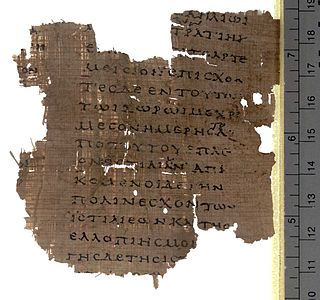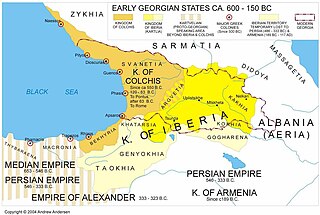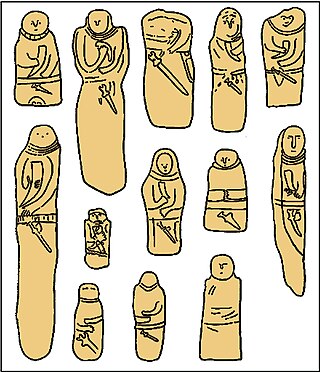Related Research Articles

An oracle is a person or thing considered to provide insight, wise counsel or prophetic predictions, most notably including precognition of the future, inspired by deities. If done through occultic means, it is a form of divination.

The Scythians or Scyths in composition) and sometimes also referred to as the Pontic Scythians, were an ancient Eastern Iranic equestrian nomadic people who had migrated during the 9th to 8th centuries BC from Central Asia to the Pontic Steppe in modern-day Ukraine and Southern Russia, where they remained established from the 7th century BC until the 3rd century BC.

The Hanging Gardens of Babylon were one of the Seven Wonders of the Ancient World listed by Hellenic culture. They were described as a remarkable feat of engineering with an ascending series of tiered gardens containing a wide variety of trees, shrubs, and vines, resembling a large green mountain constructed of mud bricks. It was said to have been built in the ancient city of Babylon, near present-day Hillah, Babil province, in Iraq. The Hanging Gardens' name is derived from the Greek word κρεμαστός, which has a broader meaning than the modern English word "hanging" and refers to trees being planted on a raised structure such as a terrace.

The Neuri or Navari were an ancient Baltic people whose existence was recorded by ancient Graeco-Roman authors.

The Agathyrsi were an ancient people belonging to the Scythian cultures who lived in the Transylvanian Plateau, in the region that later became Dacia. The Agathyrsi are largely known from Herodotus of Halicarnassus's description of them in the 5th century BC.
Gelonus was, according to Herodotus, the capital of the Gelonians.

The Histories of Herodotus is considered the founding work of history in Western literature. Although not a fully impartial record, it remains one of the West's most important sources regarding these affairs. Moreover, it established the genre and study of history in the Western world.

Prunus padus, known as bird cherry, hackberry, hagberry, or Mayday tree, is a flowering plant in the rose family. It is a species of cherry, a deciduous small tree or large shrub up to 16 metres (52 ft) tall. It is the type species of the subgenus Padus, which have flowers in racemes. It is native to northern Europe and northern and northeast Asia, and is grown as an ornamental in North America.
The Massagetae or Massageteans, also known as Sakā tigraxaudā or Orthocorybantians, were an ancient Eastern Iranian Saka people who inhabited the steppes of Central Asia and were part of the wider Scythian cultures. The Massagetae rose to power in the 8th to 7th centuries BCE, when they started a series of events with wide-reaching consequences by expelling the Scythians out of Central Asia and into the Caucasian and Pontic Steppes. The Massagetae are most famous for their queen Tomyris's alleged defeating and killing of Cyrus, the founder of the Persian Achaemenid Empire.
The Issedones (Ἰσσηδόνες) were an ancient people of Central Asia at the end of the trade route leading north-east from Scythia, described in the lost Arimaspeia of Aristeas, by Herodotus in his History (IV.16-25) and by Ptolemy in his Geography. Like the Massagetae to the south, the Issedones are described by Herodotus as similar to, yet distinct from, the Scythians.

The Tauri, or Taurians, also Scythotauri, Tauri Scythae, Tauroscythae were an ancient people settled on the southern coast of the Crimea peninsula, inhabiting the Crimean Mountains in the 1st millennium BC and the narrow strip of land between the mountains and the Black Sea. According to the sources, the Tauri were the first inhabitants of the Crimean peninsula and never abandoned its borders. They gave their name to the peninsula, which was known in ancient times as Taurica, Taurida and Tauris.
The Median dynasty was, according to the ancient Greek historian Herodotus, a dynasty composed of four kings who ruled for 150 years under the Median Empire. If Herodotus' story is true, the Medes were unified by a man named Deioces, the first of the four kings who would rule the Median Empire, a mighty empire that included large parts of Iran and eastern Anatolia.
The Budini were an ancient Scythian tribe whose existence was recorded by ancient Graeco-Roman authors.
The Gelonians or Geloni were an ancient Scythian people whose existence was recorded by ancient Graeco-Roman authors.

Ancient Aethiopia, first appears as a geographical term in classical documents in reference to the upper Nile region of Sudan, areas south of the Sahara, and certain areas in Asia. Its earliest mention is in the works of Homer: twice in the Iliad, and three times in the Odyssey. The Greek historian Herodotus uses the appellation to refer to such parts of sub-Saharan Africa as were then part of the known world.

The Tibareni were a people residing on the coast of ancient Pontus referred to in Herodotus, Xenophon, Strabo and other classical authors. The Tibareni were believed to be of Scythian origin, but modern scholars generally identify them as proto-Kartvelian. Tabalians are often thought to represent the same ethnic group.

The Scythian religion refers to the mythology, ritual practices and beliefs of the Scythian cultures, a collection of closely related ancient Iranic peoples who inhabited Central Asia and the Pontic–Caspian steppe in Eastern Europe throughout Classical Antiquity, spoke the Scythian language, and which included the Scythians proper, the Cimmerians, the Sarmatians, the Alans, the Sindi, the Massagetae and the Saka.
The Padaei or the Padaeans are an Indian tribe described by the Greek historian Herodotus in The Histories. Herodotus describes them (III.101) as being darker than other Indians and living in a place which is very distant from Persia towards the south and east. An extract from his work (III.99) includes the following:

Scyles, Skyles, or Scylas, was a Scythian king who lived in the 5th century BC. He is mentioned in the histories of Herodotus as having been an admirer of Greek culture and traditions, which led to his falling out of favor with his people and being executed by his brother.
References
- ↑ Asheri, David; Lloyd, Alan; Corcella, Aldo (2007). A Commentary on Herodotus, Books I-IV. Oxford: Oxford University Press. p. 598. ISBN 9780198149569.
- 1 2 Hawes, Greta (2017). Myths on the Map: The Storied Landscapes of Ancient Greece. Oxford: Oxford University Press. p. 259. ISBN 9780198744771.
- ↑ Minns, Ellis Hovell (2011). Scythians and Greeks: A Survey of Ancient History and Archaeology on the North Coast of the Euxine from the Danube to the Caucasus. Cambridge: Cambridge University Press. p. 108. ISBN 9781108024877.
- ↑ Herodotus (2011). The History of Herodotus. A new English version, edited with copious notes and appendices embodying the chief results, historical and ethnographical, discovery. Vol. III, New Edition. Translated by George Rawlinson. British Library, Historical Print Editions, United States. p. 21. ISBN 9781241693930.